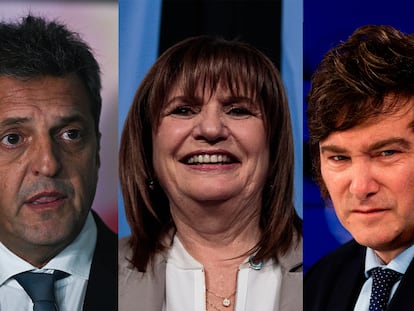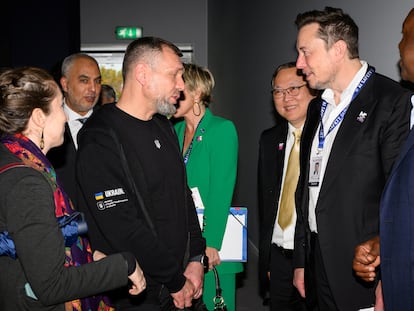Vanina Berghella, journalist: ‘We are better prepared for artificial intelligence than we were for social media’
The Latin America director of the International Fund for Public Interest Media (IFPIM) reflects on independent journalism, the impact of artificial intelligence and the polarization in Argentine society

Vanina Berghella is a kind of megaphone… the same name she gave her blog in the 2000s, when these spaces were just beginning to become popular in Latin America. There, the Argentine journalist spoke about the impact of new technologies on media and experienced what she calls the first “click” in her career. “I understood – from that moment onwards – that we journalists wouldn’t have the final word. We’d have to find a way to [engage] with those new voices that had suddenly emerged.”
Two decades ago, she began to wonder about the financial sustainability of the media. She subsequently redirected the focus of her work. Today, she continues to push others to continue in the effort to create and sustain media.
Berghella is the director of the Latin American region for the International Fund for Public Interest Media (IFPIM). The organization advises, accompanies and financially supports dozens of independent media outlets in Central and South America. From her home in Buenos Aires, she speaks with EL PAÍS about the polarization of Argentine society, independent journalism in the region and the impact of artificial intelligence (AI) on the media.
Question. We’re experiencing extreme democratic processes in different parts of the region. In Argentina, for example, we’ve seen the emergence of the far-right Javier Milei. What role do you think the media has had in this?
Answer. The word “laboratory” applies very well to what’s going to happen from now on. Argentina comes from a long process of conflict, which began with economic degradation, but which has had an impact on social issues, on the political debate. Regarding the media: in recent years, [various outlets] have suffered in quality because of the polarization of society. Very few have not been impacted by this polarization.
We shouldn’t have been surprised by [what happened to our media]. This was merely a symptom of the problems we’ve had… of the inability to resolve many problems that our country has had. Each media outlet has taken a political position that – in some cases – has ended up radicalizing certain positions [of consumers]. The agenda of what society really needs has been lost.
Q. Milei also seems like a product of the media, as he was a TV panelist before entering politics. What does that tell us about how we’re building the leaders that end up making the decisions for our countries?
A. I would divide the analysis into two parts. On the one hand, it’s true, [Milei] began to be known through the media as a panelist who commented and debated on economics issues. He had a lot of ratings on television due to his effervescent personality, which – at times – bordered on violence. Now, the media has no responsibility for him later going down the political path: they had a character who was interesting, got them ratings… he began to have visibility and impact.
The second part occurs once he enters politics, runs for president and launches all his proposals. There, the media did have a priority space for this candidate who was gaining ground. This past year, the media gave a huge amount of space to the candidate who eventually became the president.
At first, I think this happened out of curiosity, because he also [increased viewership] like when he was a panelist… but finally, in the primaries, when he became one of the most-voted candidates, it was a shock. From that moment, the media began to be more cautious [and] clearer about what this particular candidate implied.
Q. What lessons can this teach us?
A. For many years, we’ve talked a lot about the impact of social media. [But] we’ve somewhat left aside the analysis of the place that traditional media has. In this election [in Argentina], social media had a lot of impact, because Milei created a community on TikTok and YouTube. That was like his own space, where he engaged with his followers. But when he got a foothold in traditional media – especially in the last stage of the campaign – there was a huge impact. The lesson, then, is that traditional media continues to have influence and the media outlets themselves have to [embrace] that value and understand that what appears on their websites and pages is important.
Q. It’s often repeated that traditional media is in crisis and that people aren’t consuming it.
A. I think that people consume it. There are two elements in recent years that have marked this tendency. One was the pandemic. Throughout the first year of Covid and during the second wave, the growth of the media audience was exponential. People stopped just getting information through social media – [they began to] go and verify the information, or check it against traditional media. That was shocking. Then, they lost interest, people got tired of us – [we were] only talking about the pandemic or bad things and they looked for other spaces, not only to be informed, but to be entertained. But that was proof that people – in the worst moment, when there was massive fear and uncertainty – went to the media and expected to at least obtain [quality] information [and hear from] scientists and doctors who would speak to them from a position of authority.
The other moment took place during the elections [in Argentina]. People ended up consuming everything that was happening with this candidate (Milei)... on television, especially.
Q. In addition to social media, there’s now the artificial intelligence factor. How do you think AI is toying with the media and its impact on democracy?
A. The media is better-prepared for AI as a technology – as a phenomenon and novelty – than it was when social media emerged. We all thought that social media networks were a good thing – that everything would be positive, collaborative, open, beneficial. However, we hadn’t foreseen the negative consequences. With AI, we’re more alert. Since it appeared at the end of last year, it never had the honeymoon that social media had. We began to ask about the regulations and verification of information right away.
Q. What should the media focus on so as to not be swept away by AI?
A. The important thing, in this instance, is learning how to validate the information that’s produced with AI and check what comes from qualified sources, political parties, the government and organizations. It’s not a question of demonizing technology: what we have to do is use it to our advantage and be very alert.
Q. You were a pioneer of blogging. You’ve written about how we need a responsible usage of social media… “neither censorship nor anarchy,” to quote you. How responsible have we been?
A. Journalists made many mistakes. At the beginning, there was a lot of rejection, they demonized social media, thinking that it was a tool that could take away their jobs. But, in the end, many managed to make their professional profiles visible [via social media] and show their work in a more human, direct and clear way to audiences. [Social media] also had an impact on capitalizing on those audiences, building their loyalty and gaining traction.
Not only through comments, but also through metrics, [a journalist] can know exactly who are the people who follow them. There is, however, a complex and unresolved aspect, which is the relationship with the large platforms. Many media outlets became addicted to the distribution of their content on social media, to generate traffic. But as these platforms have modified their algorithms and priorities, they’ve sentenced some small media outlets to death, or they’ve taken traffic away from them.
Q. When we talk about the crisis in credibility felt by audiences, do you have any hope?
A. Working with journalists [from my organization] makes me fall in love with the field again, because I see something that perhaps cannot be transmitted to the audience, which is passion. A journalist is a journalist because they’re passionate about what they do, not because of what they earn, nor because of the name of their organization. Journalism, in general, should do a service to society. Unfortunately, we fail to convey this to our audiences. Doing so would generate much more empathy [for reporters].
Q. What do you recommend to bring audiences and journalists closer together?
A. Society is at a point where – to fall in love with journalism again and for us to consume and pay for journalism – we need more transparency, self-criticism and revaluation of an old journalistic technique [that needs to be able] to make rectifications and recognize errors.
Q. Your job is to guide and support small, independent media outlets that are trying to sustain themselves. How’s their health in Latin America?
A. The general health of both large and small media outlets is complex. There’s a big problem with the financing model – the decline in advertising revenue is constant and increasingly noticeable. The traditional ones – which are generally large corporations – may have other businesses that facilitate financing journalism. But in the smaller ones, if they don’t get philanthropic financial support, they cannot start their operations and then, it’s difficult for them to maintain themselves.
However, the latter are very creative: some work with membership groups, others generate events that allow them to inject funds to sustain part of the structure, or they develop services for other media outlets. Due to their size and scale, they have sufficient mobility to generate other financing models. It’s a tiring path and that’s why it’s important to support them, so that this media base doesn’t deteriorate. Because what usually happens is that the largest ones survive and the smallest ones lose strength.
Q. Has the presence of women in media management positions made any progress?
A. Since 20 years ago – when I started – the situation has improved a lot. There’s a much bigger presence of women in relevant positions in the media. But of course, there’s still a long way to go.
Entrepreneurial [media] and digital media have a different reality: many [of these outlets] have been founded by women or have female leaders on their executive committees, or in their management areas. There are also more and more support and training programs for women.
Q. And in terms of diversity?
A. This is much more limited. When we talk about diversity, we’re referring to all kinds, including people with different abilities, or the presence of rural or Indigenous communities. They all bring a different perspective. In all countries [in Latin America], we’re behind in this regard. We all bear responsibility – communities that have achieved space [need to contribute]: women can open space to journalists from the trans community, for example.
In addition to the fact that [diversity] is a matter of law, media outlets [often forget] that it’s an opportunity to reach new audiences. Traditional media should have more plurality.
Q. And what’s surprising about the media industry in Latin America?
A. [When we talk about small media outlets in the region], they’re talking about doing good to others. Journalism in general – done by journalists who seek to do good for others – is something that exists and will continue to exist. What we have to achieve is for this to be more visible in society.
Sign up for our weekly newsletter to get more English-language news coverage from EL PAÍS USA Edition
Tu suscripción se está usando en otro dispositivo
¿Quieres añadir otro usuario a tu suscripción?
Si continúas leyendo en este dispositivo, no se podrá leer en el otro.
FlechaTu suscripción se está usando en otro dispositivo y solo puedes acceder a EL PAÍS desde un dispositivo a la vez.
Si quieres compartir tu cuenta, cambia tu suscripción a la modalidad Premium, así podrás añadir otro usuario. Cada uno accederá con su propia cuenta de email, lo que os permitirá personalizar vuestra experiencia en EL PAÍS.
¿Tienes una suscripción de empresa? Accede aquí para contratar más cuentas.
En el caso de no saber quién está usando tu cuenta, te recomendamos cambiar tu contraseña aquí.
Si decides continuar compartiendo tu cuenta, este mensaje se mostrará en tu dispositivo y en el de la otra persona que está usando tu cuenta de forma indefinida, afectando a tu experiencia de lectura. Puedes consultar aquí los términos y condiciones de la suscripción digital.
More information
Archived In
Últimas noticias
Welcome to the post-religion era: The idea of Christianity as the absolute truth has become obsolete
‘I thought you would like it’: The risky sexual practice popularized by TV shows and TikTok
The digitalization of tourism: ‘They promise experiences and gave us the worst possible one’
Mexican peso defies uncertainty with forecasts of a new period of stability in 2026
Most viewed
- Sinaloa Cartel war is taking its toll on Los Chapitos
- Reinhard Genzel, Nobel laureate in physics: ‘One-minute videos will never give you the truth’
- Oona Chaplin: ‘I told James Cameron that I was living in a treehouse and starting a permaculture project with a friend’
- Why the price of coffee has skyrocketed: from Brazilian plantations to specialty coffee houses
- Silver prices are going crazy: This is what’s fueling the rally










































